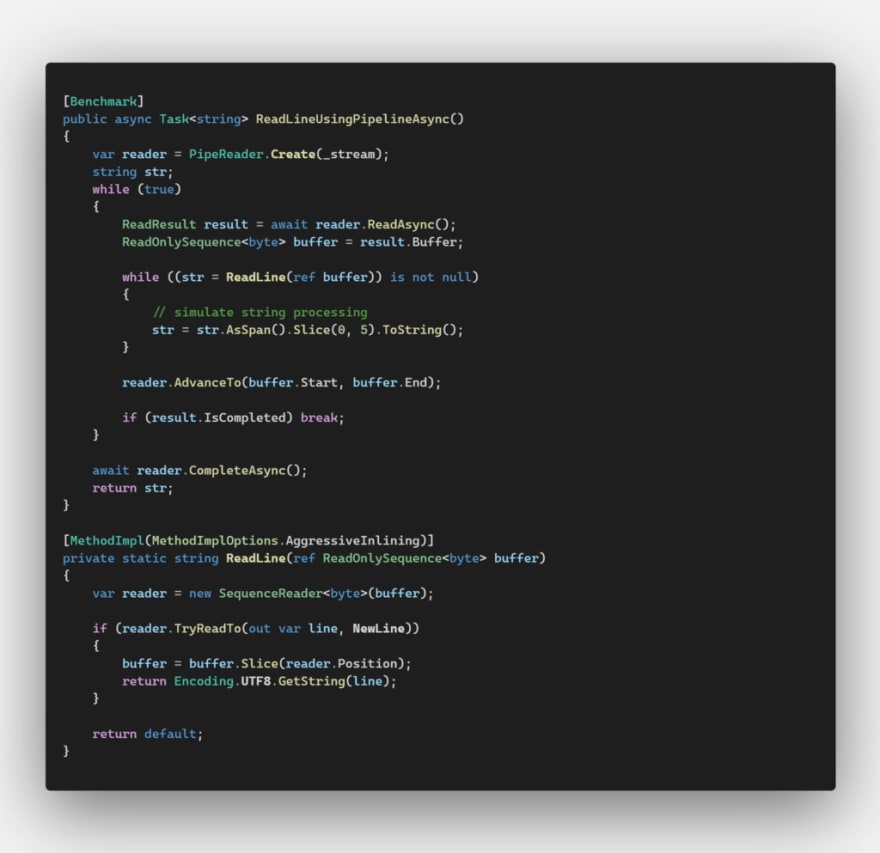Evaluating “ReadLine using System.IO.Pipelines” Performance in C#

Joni 【ジョニー】
Posted on August 16, 2020
Read string line by line using System.IO.Pipelines API in C
A typical approach for reading a string line by line from a file would probably be using ReadLine APIs. I have heard all good things about System.IO.Pipelines, which was born from the work of the .NET Core team to make Kestrel one of the fastest web servers.

 Ben Adams #BlackLivesMatter@ben_a_adams
Ben Adams #BlackLivesMatter@ben_a_adams Round 19 of @TFBenchmarks is out and ASP.NET Core on Linux racing to the top!
Round 19 of @TFBenchmarks is out and ASP.NET Core on Linux racing to the top!
Who would have thought .NET would have been fully OSS and top performer *on Linux* a several years ago? #aspnetcore #dotnet
techempower.com/benchmarks/#se…23:04 PM - 28 May 2020
Although it is probably better suited for network socket IO, I was wondering how easy and how does it perform compared to the traditional ReadLine APIs? So I decided to give it a spin by creating simple benchmarks using BenchmarkDotNet as part of my learning journey.
But, for this post, instead of using a file as the source of the stream, I decided to use in-memory, presumably more-stable-for-benchmark MemoryStream. Feel free to modify it to use a file as the stream source and try it yourself.
The code for ReadLine is so dead simple; nothing fancy here.
(My apologies for the possibly misleading method name ReadLineUsingStringReaderAsync; it doesn’t use StringReader class at all).
You will probably spot that unfamiliar C# 9.0 Pattern Combinators is not null; Yes, I’m using the latest (at the time of writing) .NET 5 Preview 7 (5.0.0-preview.7) and the preview version of Visual Studio (Version 16.8.0 Preview 1.0). Don’t blame me, I love bleeding edge stuff!😎
See how is not null is transformed here.
To simplify the processing of a ReadOnlySequence, here I used SequenceReader; taken from the official sample here, modified it slightly to make it follow a similar pattern while (... is not null) as ReadLineUsingStringReaderAsync does.
And finally, here is the result: 40 benchmarks in 15 minutes on my machine.
Here is the gist version:
Legends:
LineNumber : Value of the 'LineNumber' parameter
LineCharMultiplier : Value of the 'LineCharMultiplier' parameter
Mean : Arithmetic mean of all measurements
Error : Half of 99.9% confidence interval
StdDev : Standard deviation of all measurements
Ratio : Mean of the ratio distribution ([Current]/[Baseline])
RatioSD : Standard deviation of the ratio distribution ([Current]/[Baseline])
Gen 0 : GC Generation 0 collects per 1000 operations
Gen 1 : GC Generation 1 collects per 1000 operations
Gen 2 : GC Generation 2 collects per 1000 operations
Allocated : Allocated memory per single operation (managed only, inclusive, 1KB = 1024B)
Code Size : Native code size of the disassembled method(s)
1 ms : 1 Millisecond (0.001 sec)
You can find the source code in my GitHub repository.
Conclusion
- Pipelines versions are better in terms of memory usage (using less memory).
- In terms of speed, it is surprisingly slower than the ordinary ReadLine version given the string length ≤ 80 (perhaps I am doing it wrong? Let me know! I am still learning!). It is starting to shine, getting faster and faster if the string length ≥ 90. (270% 🚀 faster for string length = 1000).
- Less GC pressure (a good thing) for Pipelines versions (Gen 0, Gen 1).
- The amount of code to write for the Pipelines version is longer.
[Update] See part 2 of this series for a better version! (Spoiler: faster on every test!)
DISCLAIMER: Your mileage may vary. As with all performance work, each of the scenarios chosen for your application should be measured, measured and measured. There is no silver bullet.
Resources:

Posted on August 16, 2020
Join Our Newsletter. No Spam, Only the good stuff.
Sign up to receive the latest update from our blog.




